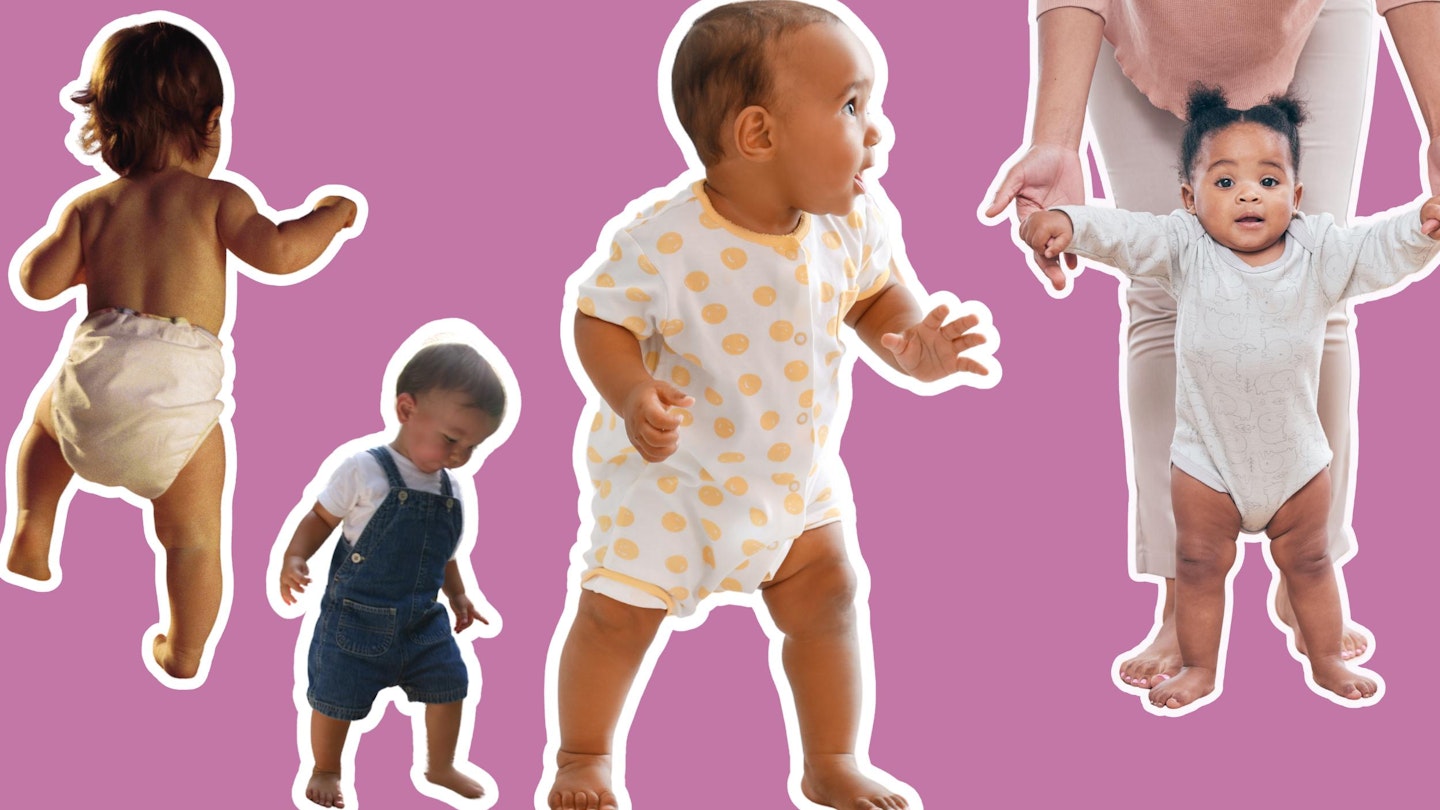Every parent eagerly anticipates the magical moment when their baby takes its first wobbly steps. But the big question is: When do babies start walking? It’s one of those baby milestones that feels like a rite of passage, signalling the shift from a tiny, dependent newborn to a curious, independent toddler.
While it might seem like a straightforward milestone, the timing can vary from one baby to the next. Some little ones take their first steps as early as nine months, while others might not be strolling until closer to 15 months.
Understanding when babies typically start walking and what factors influence that timing can help ease any worries and give you a better understanding of your child's development. So, let’s break down the walking timeline, from when your baby starts crawling to cruising, and explore what to expect as your baby takes those important first steps toward independence.
We spoke with paediatric physiotherapist Karen Mayes to give you a comprehensive guide on everything you need to know about when your baby might take their first steps and how you can support their development. With her expert insights, we’ll walk you through the typical timelines, the factors that influence when babies start walking, and practical tips to help encourage your little one’s mobility in a safe and healthy way.
What age do babies walk?
"Some babies start walking as early as nine months, while most take their first independent steps around their first birthday. A few may even wait until 18 months," says Karen Mayes.
But when your little one starts walking, it isn’t just determined by age; temperament plays a big role. Research shows that even if babies are great at cruising (that’s when they walk holding onto furniture), their personalities can affect when they take those first solo steps. For instance, cautious kids may hang on longer for support until they feel confident, while more adventurous ones might take a few bold, wobbly steps before tumbling.
By 18 months, most babies have taken a few independent steps, and many are walking confidently on their own. But here’s an important reminder: it’s normal for babies to reach a milestone and then regress. Don’t worry; this is completely typical baby behaviour.
"If you’re worried about your baby’s development, it’s always worth checking in with your paediatrician. But remember, your baby may just be taking their time. Every child develops at their own pace, so skip the comparisons and don’t rush things," Karen advises. "When they do start walking, let them explore and practice at their own speed. This freedom helps them build coordination, balance, and a solid sense of their body’s abilities."
Signs baby will walk soon
Pulling Up to Stand - If your little one has been busy pulling themselves up to stand on furniture or your legs, that’s a big clue. They’re strengthening those muscles and getting used to the idea of standing on their own.
Cruising Like a Pro - As previously explained, cruising is when a baby walks while holding onto furniture. They're gearing up for those monumental first steps if they’re confidently moving along the couch, coffee table, or even your legs.
Squatting and Standing Back Up - That little squat-to-stand move is adorable and helps build the balance and leg strength needed for walking.
Taking Steps While Holding Your Hands - Is your baby eager to hold your hands and take a few steps with your support? If they can walk with you holding their hands, then they're building their confidence to walk.
Staying Steady on Two Feet - If your baby can balance for a few seconds while standing without support, they’re showing that their balance is starting to come together.
Remember, every baby is unique, and these milestones can vary from child to child. Whether it happens early or a little later, rest assured your little one is on their own path to walking; just give them time, encouragement, and a safe space to explore.
How do babies learn to walk?
"There are lots of skills and walking milestones that babies need to master before getting up on two legs," says Karen. "Both physical and cognitive skills play a role."
So, what are those skills? And is there anything we parents can do to help our babies along the road?
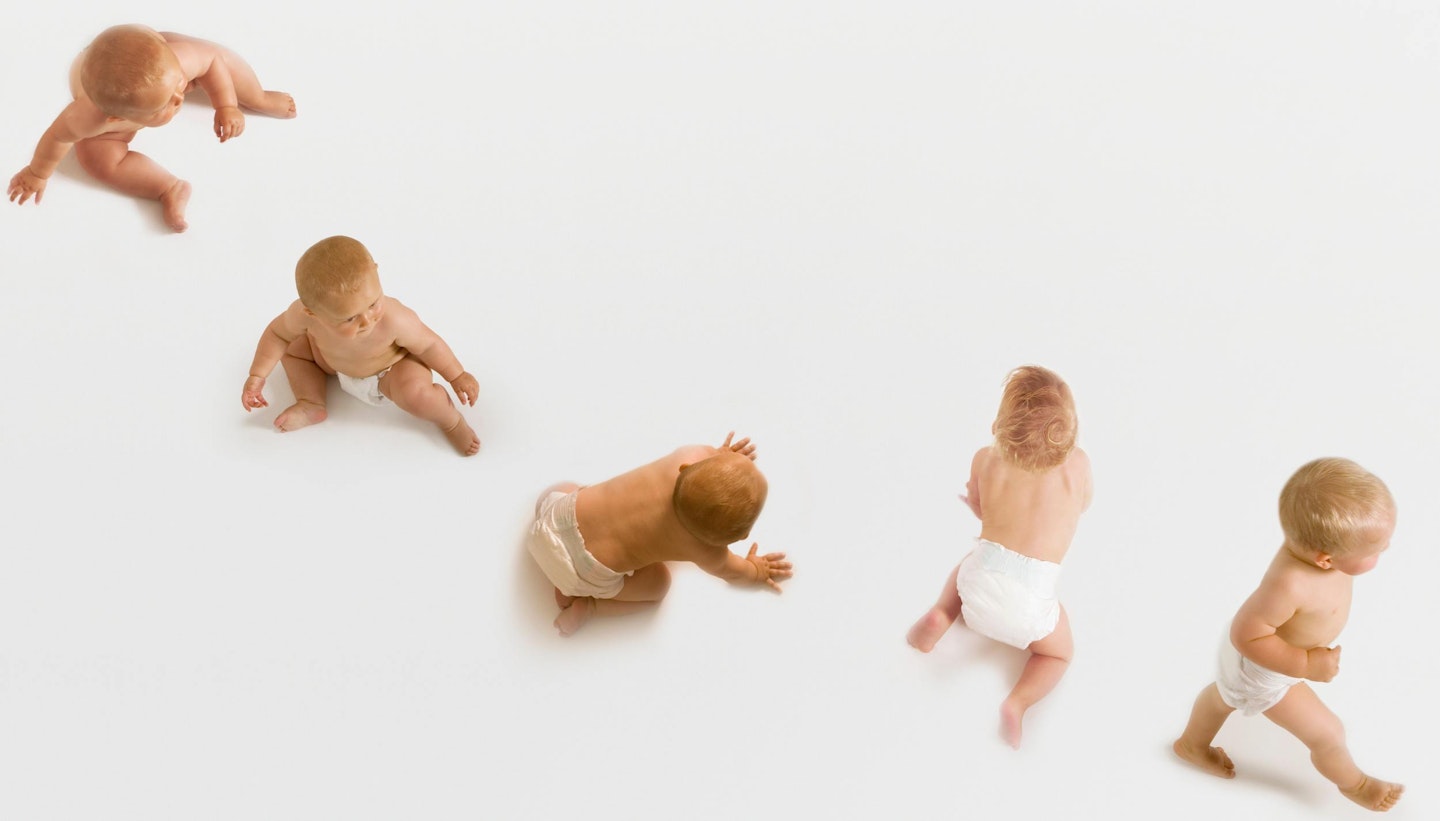
Stages of learning to walk
Step One: Head control
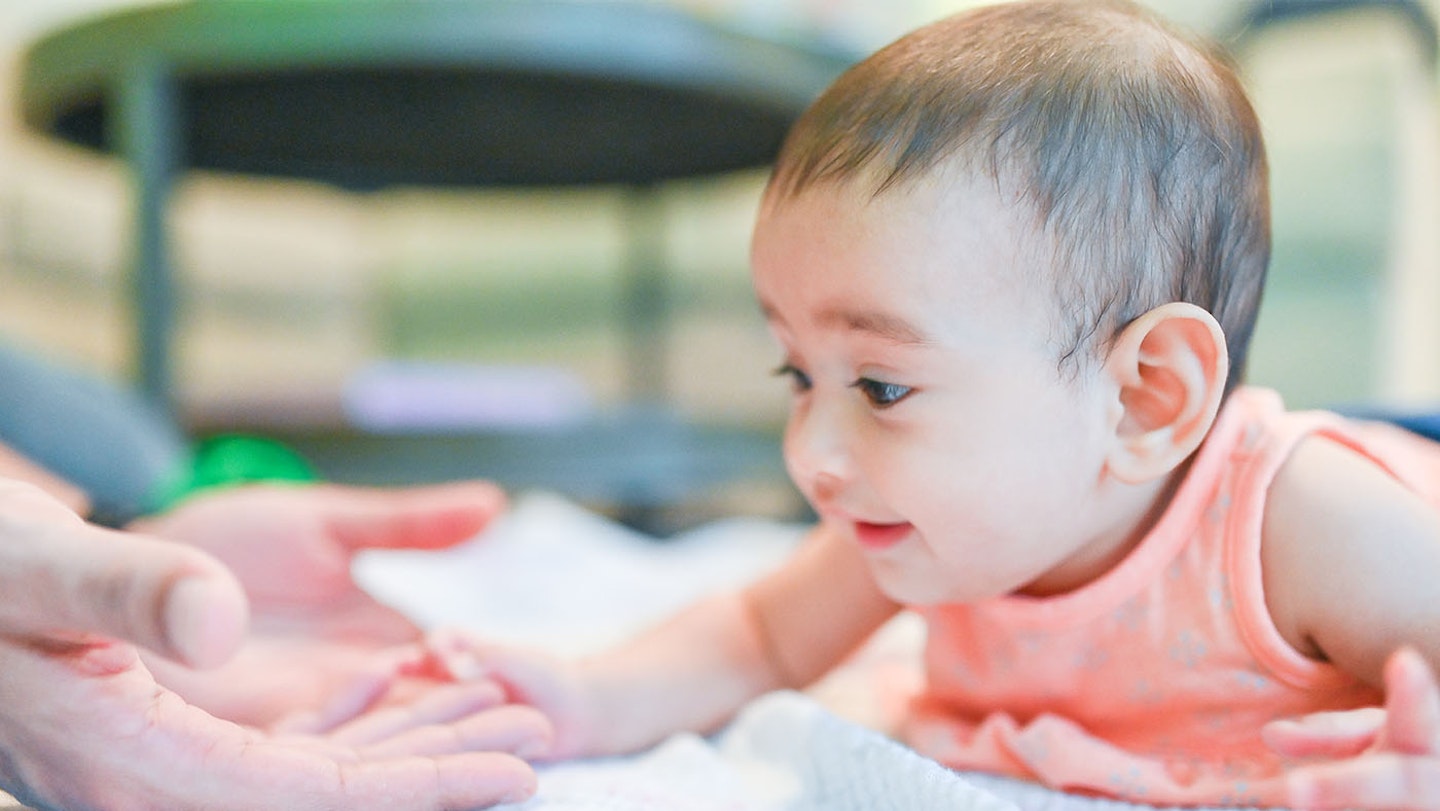
"The first ‘pre-walking’ skill that babies need to master is head control," says Karen. "We need to be able to hold our heads steady before we can move around at all – or even sit."
In the womb, babies’ heads are supported by watery amniotic fluid. But when they’re first born, their neck muscles aren’t strong enough to hold their heads up against the pull of gravity. That’s why it’s important to support their neck and head when you’re holding them. It's advised to regularly have tummy time each day to help strengthen those head and neck muscles.
"As a rule, babies will start to develop their neck muscles enough to raise their head – slightly - somewhere between three and six weeks old," says Karen. "But it can take up to six months for your baby to be able to hold their head up steadily, without any support."
Step two: Body awareness
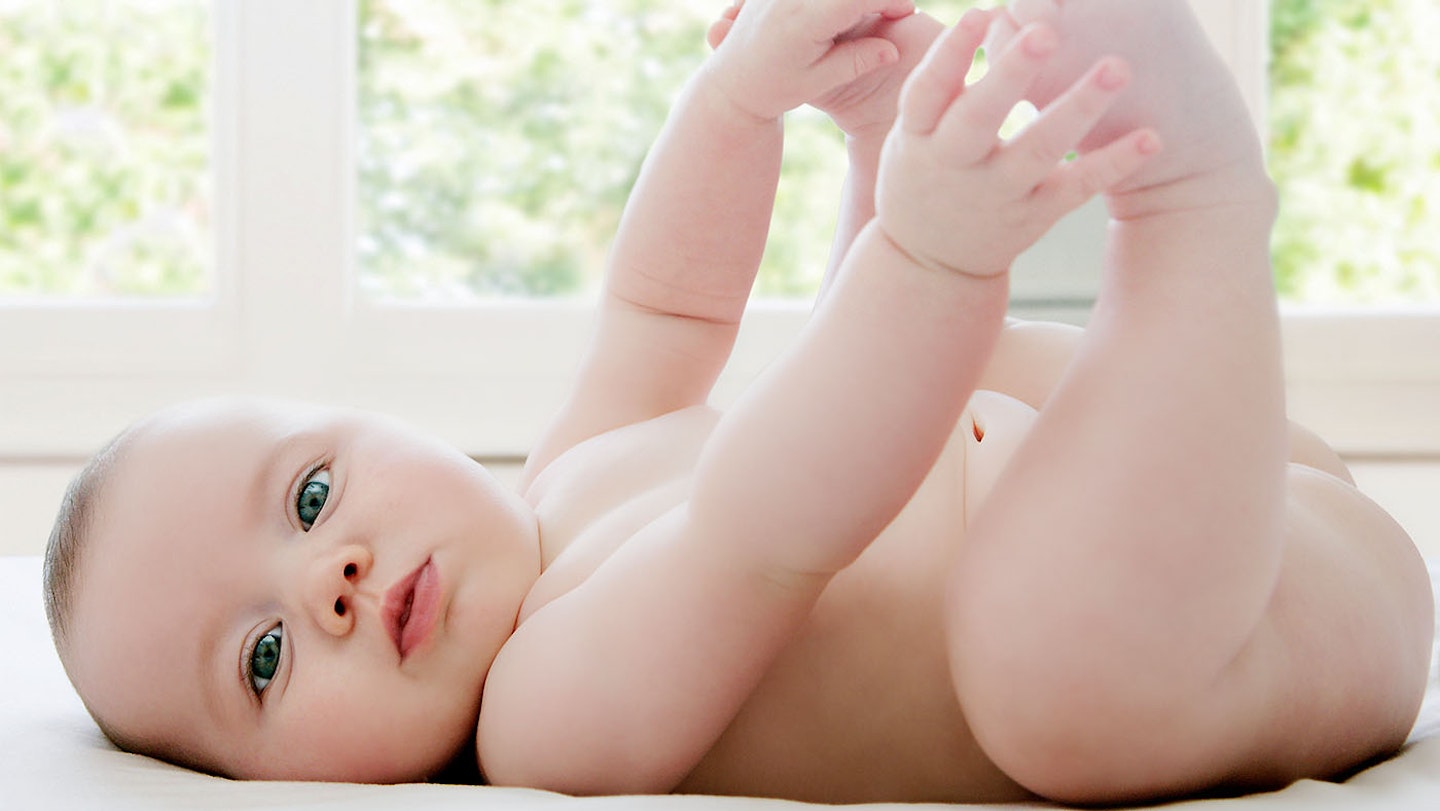
"To walk, we all need to be aware of our own body’s position in space and the position of other objects," says Karen. "So babies need to develop spatial awareness. When they start to explore their body, it’s a sign that they’re motivated to explore the environment around them. That curiosity will eventually be the thing that propels them up onto their feet to look around!"
Your baby will probably ‘discover’ their feet for the first time when he is between two and five months old. They'll start to develop hand-to-eye coordination between three and six months. And the more they reach and grab, the better their spatial awareness will become.
Step three: Rolling
Rolling is a seriously complex move. When your baby masters this move, it means they've built up all their core muscles, and their trunk is getting well-and-truly toned. It means they've got enough body awareness to rotate their bottom half (pelvis and legs) away from their upper body – which is what they need to do to move into the roll. And it means both sides of their brain are working together to coordinate the movement.
"Some babies roll at three months," says Karen, "but you’re most likely to see your baby doing this between four and eight months. And some babies won’t roll until they’re nine months old."
Step four: Sitting

"To sit up, babies need good head control and strong abdominal and trunk muscles," says Karen. "Babies usually reach this stage between six and eight months." Building up these muscles is all about getting an opportunity to move around on the floor, or in a baby gym, anywhere where they’re not constrained in a pram or car seat.
Step five: The four-point pose
"The four-point pose is when your baby is up in the crawl position – on their hands and knees – but they aren't actually crawling," says Karen. "It’s really tempting to want your baby to take off at this stage, but don’t rush it.
Getting into this position and holding it is helping your baby strengthen the weight-bearing ability of their hips, shoulders and hands. That’s key for helping them walk later on. You often see babies rocking themselves back and forth when they’re in this position. This helps to deepen the curve of their hip socket and make that joint stronger."
Babies often manage to get into this position around six months old, but some of them adopt other ways of getting around. Some commando crawl – use their arms to creep forward – while others get into a bottom shuffle position. This tends to happen because they have more strength in their arms (commando) or legs (shuffle) than they do in their trunk.
"These ways of getting around are totally normal," says Karen. "But you may find they take slightly longer to get up on their feet than babies who crawl. Babies need a strong core and trunk to move onto walking. Plus, it’s easier for babies to pull themselves up onto their feet from a crawl position than from a commando or bottom shuffle position. But they’ll get there in their own good time."
Step six: Crawling
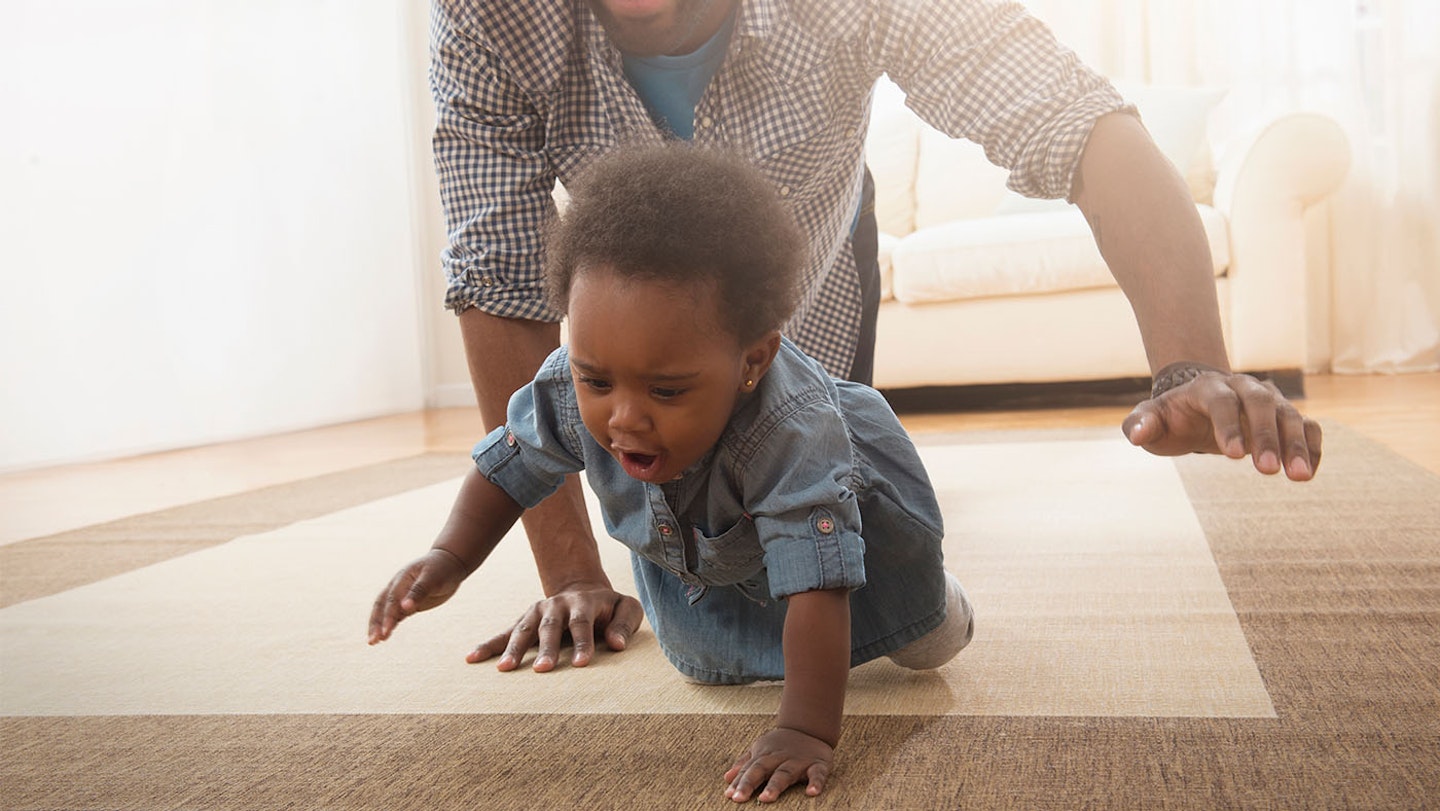
"To crawl, a baby has to learn how to transfer their weight from one side to the other," says Karen. "They also have to coordinate both sides of their body to move steadily. This usually happens when they're between six and 12 months old."
Some babies crawl backwards before they crawl forwards. This is fine – they’re leading with their legs and arms following. It won’t be long before they figure out how to go forward.
Step seven: High kneel and cruising
"Going from crawling to cruising usually comes in two steps," says Karen. "First, you’ll see your baby going up into a high kneel, so their arms are off the ground, and they're balancing on their knees (usually using the sofa or a solid chair/ table) as a support. You can help them get steady in this position by putting toys on the sofa for them to play with. Then, when they're ready, they'll try pulling themselves up. If you can see they want to do this, try putting a toy slightly further away to see if that gets them up higher. The earliest this tends to happen is around eight months old. As their confidence and strength build, they'll start to cruise, hang onto the sofa (or you) and take small steps along."
Step eight - Walking!
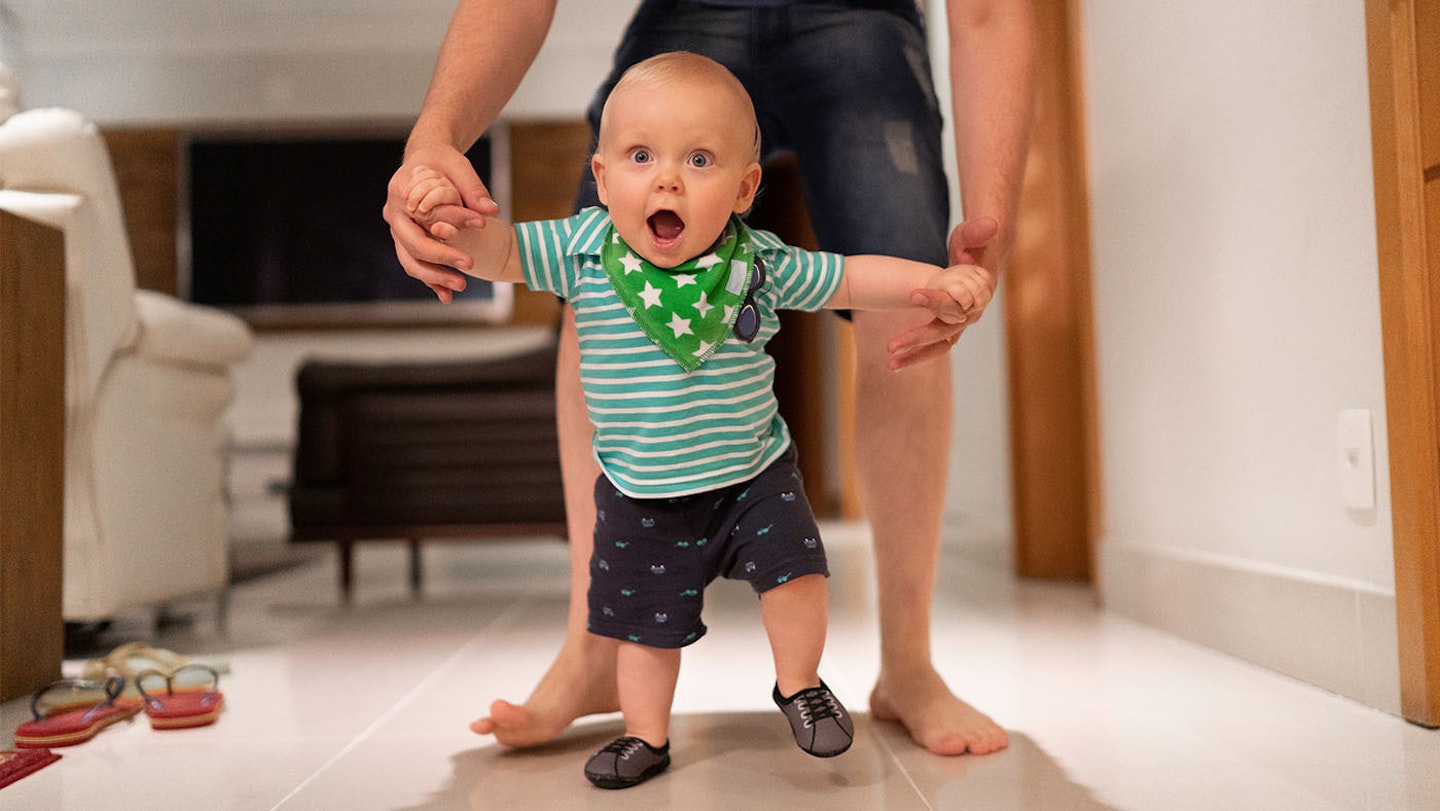
Babies typically start walking independently between nine and 18 months old.
Each baby develops at their own pace, so variations in the timing of these milestones are normal.
How to encourage a baby to walk?
Create a soft walking environment - Provide your baby with soft surfaces to walk on, as they will likely fall frequently. A padded play mat or carpet can help cushion those falls.
Go shoe-free - "Let them spend as much time as possible walking without shoes on," advises Karen. Barefoot walking helps babies develop their foot muscles and balance naturally. If shoes are necessary, choose lightweight, flexible options that allow for natural foot movement.
Support at the Hips - "During the early days of walking, try not to hold their hands too much," Karen suggests. Instead, support your baby at the hips. This method encourages balance through their trunk and legs, fostering better coordination and strength.
Use a push trolley or baby walker - Baby walkers and pull toys do not teach babies to walk and are not essential parts of development, but they can be fun toys for your baby to play with. Push toys and walkers are excellent for encouraging independent mobility. They satisfy your baby’s desire to move while stimulating the neurological patterns associated with walking.
Encourage cruising - Allow your baby to practise cruising along furniture. This helps them gain confidence and stability while transitioning to walking.
Incorporate fun and motivation - Place toys, favourite objects, or even yourself a short distance away to motivate your baby to take steps towards them. Engaging in playful activities can make walking practice enjoyable and rewarding.
Create a safe space - Baby-proof your home to create a safe environment for your little one to explore. Remove sharp edges, secure furniture to the wall, and ensure no small objects are within reach. A safe environment encourages babies to experiment with walking without unnecessary risks.
Practice standing and balancing - Encourage your baby to stand by themselves by placing toys or objects just out of reach. This will help them build the strength and balance needed for walking. Praise and celebrate their efforts to boost their confidence.
Model walking - Show your baby how to walk by walking around and getting excited when they take steps. Kids often learn by copying, so seeing you walk and cheer for them can really motivate them to practise more. Try making it fun by singing the "Walking, Walking, Hop Hop Hop" nursery rhyme. Your baby will love the playful interaction and might light up with excitement!
Consistency is key - Practice walking a regular part of your daily routine to give your baby plenty of opportunities to practise in a supportive and encouraging environment. If the weather permits, consider practising in the park where the grass provides a softer surface for falls.
The dangers of baby walking too early
While it’s exciting when babies start walking, walking too early can have risks. Babies need time to develop the muscle strength and balance required for safe walking. If they start walking before their body is ready, typically around 12 months, they may struggle with coordination, leading to more falls and potential injuries. So, it’s best to let babies reach their walking milestones naturally when their bodies are fully prepared and when they are ready.
When to be concerned about your baby's walking progress
If your baby isn’t walking by around 18 months, it’s worth mentioning to your doctor. While some babies may take their first steps a little later, most are walking confidently by 18 months. Delayed walking could sometimes be linked to developmental or motor issues, but it’s important to remember that every baby is unique.
The NHS suggests that if your child hasn’t started walking by 18 months or shows other signs of developmental delays, it’s a good idea to seek professional advice to rule out any underlying concerns.
When to buy shoes
When your little one is mastering the art of walking, it's best to hold off on buying shoes. When your tot is barefoot, they can feel the ground beneath them, which helps them notice different textures, temperature changes, and all the little things that help them develop balance and stability.
Of course, you'll want to protect those tiny toes when heading outside. In this case, soft-soled shoes are your best bet. Think more flexibility, less fashion statement. Save trainers and trendy shoes for when they’re running marathons, not recreating Bambi on ice.
And if you've already invested in soft-soled shoes, make sure your baby's toes aren't feeling squished. A little wiggle room is key for comfort and growth. For the best fit, consider taking your little one to a shoe store where they can be properly measured.
Choosing the right shoes
According to Alex Roberts, Senior Brand Manager at Kickers, "Your little one will be wearing their shoes for a few hours most days, so it’s essential that their shoes fit properly and are comfortable.”
He advises, “New children's shoes should be 12-15 millimetres longer than their feet. The best quality materials deliver the best performance, so shoes for your little ones should be made from premium leather, which moulds to the foot for a perfect fit. Shoes should also be breathable and anti-odour."
Making sure your baby takes their first steps in well-fitted, comfortable shoes can significantly impact their walking journey. Remember, every baby is unique and will reach this milestone at their own pace.
About the expert
Karen Mayes is a dedicated paediatric physiotherapist based in North Yorkshire and a mother of two. She helps children achieve their developmental milestones. Specialising in early childhood motor development, Karen is passionate about guiding infants and toddlers through crucial stages such as crawling, standing, and walking.
About the author
Hannah Carroll is our Senior Digital Writer. In her capacity, she curates top-notch listicles, crafts insightful how-to guides, and delivers expert product reviews. As a mother of three, Hannah draws upon her comprehensive understanding of all facets of family life to bring true insight into all the products that make running a home easier.
